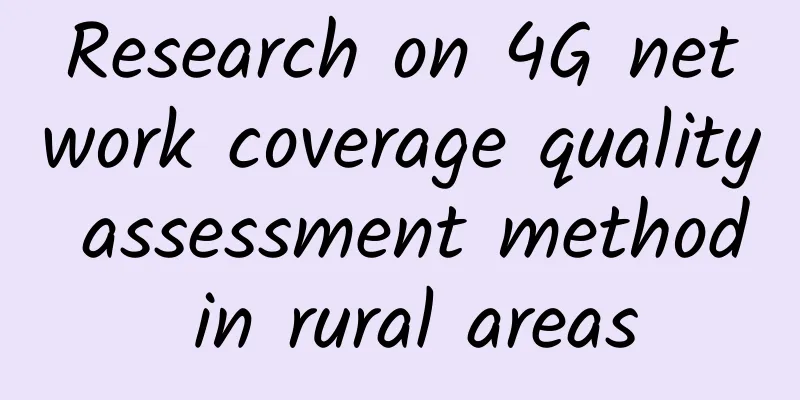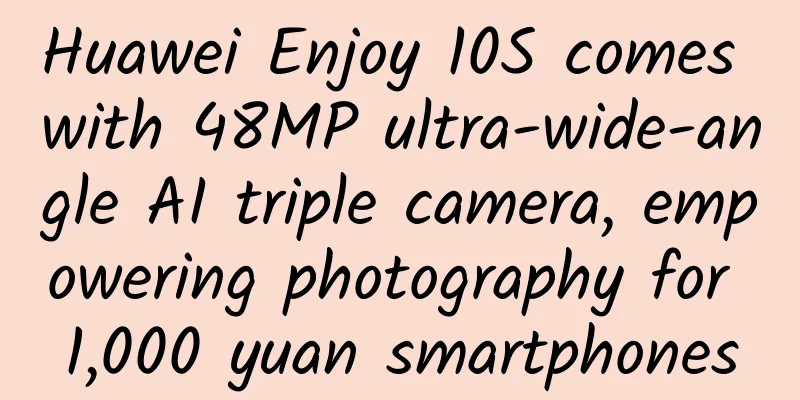Research on 4G network coverage quality assessment method in rural areas

Labs GuideThe analysis of 4G coverage quality in rural areas has always been a pain point for operators. Starting from the perspective of operators, this paper proposes a more accurate evaluation method based on MR two-dimensional data to analyze the network coverage quality of natural villages and the coverage of competitors. Since 2015, 4G network construction has gradually expanded to rural areas in towns and villages. In response to the national call for poverty alleviation, in recent years, various operators have continuously increased their 4G investment in rural areas through universal telecommunications services and rural network poverty alleviation. According to the current data, China Mobile's 4G coverage rate in administrative villages across the country has reached more than 98%, and the coverage rate of natural villages is also increasing year by year. The coverage rate mentioned here refers to the proportion of the number of administrative villages or natural villages covered, and cannot fully reflect the network coverage capacity. In order to strictly implement the goal of co-construction and sharing, the rural 4G base stations built in the past two years are basically upgraded and constructed on the site of 2G base stations, inheriting the engineering parameters of the 2G network. Although the frequency band is the same, its actual coverage capacity for administrative villages or natural villages needs further evaluation. 1. Evaluation content and methodsOperators evaluate network coverage in rural areas mainly from two aspects: one is to evaluate whether their own coverage meets the standards based on natural villages, and the other is to evaluate the difference in coverage capabilities with competitors. Unlike urban areas, where road tests can be used to evaluate network coverage quality, rural areas, especially remote rural areas and poor villages, use on-site tests in natural villages one by one, which will consume a lot of manpower and material resources. At present, the application of MR statistical data for coverage analysis is relatively common, but MR data is mainly used to find black spots of its own network coverage in continuous coverage areas, and is not often used in rural areas with scattered coverage. At the same time, when doing weaker than competitor analysis, it is often not the only basis for judgment due to low accuracy. The evaluation method discussed in this article starts from the pain points of MR data analysis. First, the location of the natural village in the coverage area to which it belongs is located, and the coverage quality of the location is accurately evaluated. Then, the accuracy of competitor analysis is improved by adding auxiliary judgment means. 1.1. Assessment of natural village coverage capacity Step 1: Obtain the longitude and latitude information of natural villages. Currently, many provinces have been able to obtain the longitude and latitude information of natural villages through the marketing departments of operators or local governments, which is the basis for the following evaluation and analysis. Step 2: Calculate the distance and azimuth between each natural village and the nearest base station. The distance and azimuth between the two points can be calculated through the longitude and latitude information of the natural village and the base station. Assuming that the longitude and latitude of the base station are (Zj, Zw), the longitude and latitude of the natural village are (Cj, Cw), and R is the average radius of the earth, the longitude and latitude of the base station and the natural village are converted into three-dimensional rectangular coordinates (Xa, Ya, Za) and (Xb, Yb, Zb) without considering the altitude. By calculating the difference in the three coordinate axis directions, the distance between the natural village and the base station is obtained.
The distance between the natural village and the base station: When calculating the azimuth, it is considered that on the longitude, for every 1 degree difference in latitude, the actual distance is about 111 kilometers; on the latitude, for every 1 degree difference in longitude, the actual distance is 111 kilometers × cos (latitude). The azimuth of the natural village point C relative to the base station point Z is expressed as an angle in a clockwise direction starting from the due north direction of Z as 0 degrees. When point C is in the first quadrant, the azimuth = α; when point C is in the second quadrant, the azimuth = 360 + α; when point C is in the third or fourth quadrant, the azimuth = 180 + α. In actual projects, for the convenience of operation, some engineering designers have compiled small programs for calculating the shortest distance between two points, and the calculation of azimuth can be integrated into it later on this basis. Step 3: Locate the cell. Obtain the azimuth information from the 4G base station parameters, compare it with the calculation result in step 2, and determine the coverage cell to which the natural village belongs. For example, the azimuths of the three sectors of a base station are 60°, 180°, and 300°, and the angle range of a sector is 0°-120°. If the azimuth of the natural village calculated in step 2 relative to the base station is 100°, then the natural village is located in the coverage range of a sector. Step 4: Evaluate the coverage quality of the natural village. After knowing the cell to which the natural village belongs, extract the MR two-dimensional data MR.TadvRsrp of the cell. This data reflects the statistical results of the UE's timing advance and the reference signal received power at the same time. Through this data, the RSRP level values measured and reported under different TAs can be obtained. A TA interval of 4G corresponds to 48 Ts, which is approximately equal to 234m. Combined with the distance between the natural village and the nearest base station, the TA interval where the natural village is located can be located and the corresponding RSRP level statistics can be obtained, thereby evaluating the actual signal coverage quality of the natural village. The coverage calculation method is shown in Table 1. Table 1 Calculation of RSRP coverage of different TA intervals in a cell using two-dimensional data MR.TadvRsrp 1.2. Evaluation of Competitive Capabilities in Natural Village Coverage When obtaining cell-level MR.TadvRsrp data to evaluate the network coverage capability, the base station can issue an inter-frequency measurement command to the terminal, and the multi-mode and multi-frequency terminals supporting other operators' 4G frequency bands can synchronously measure and report the competitive RSRP level information. The total number of sampling points in the TA interval where the natural village is located includes the sampling points of the three operators. Through analysis and processing, the network management platform can extract the number of sampling points of each operator and its RSRP level information, so as to count the coverage quality of each operator in the natural village, that is, the coverage rate. However, there are some problems in actual operation. The coverage rate is calculated according to the proportion of the number of collected sampling points greater than a certain level indicator to the total number of sampling points. If the total number of sampling points of a certain operator is relatively small, the sudden appearance of high-level sampling points may increase the coverage rate, resulting in inaccurate analysis results. The small number of total sampling points may be due to poor coverage on the one hand, and on the other hand, it may be because the user terminal does not support the competitive frequency band, resulting in no competitive coverage information being reported. In order to solve the problem of inaccurate coverage of competitors through MR analysis, some auxiliary judgment methods are generally added on the basis of MR analysis results for further analysis. For example, some cells with no surrounding competing sites but MR statistics as weaker than competitors are eliminated by combining site engineering parameters; by obtaining the MR data of competitors and rendering it on the map with their own MR data, the cells with misjudgment are eliminated. The first method is easier to operate using engineering parameters, but there are more subjective judgment factors. The second method is the most intuitive to obtain the MR data of competitors for analysis, but it is extremely difficult to obtain competitor data. In view of this, this paper proposes a new auxiliary judgment method, which preliminarily judges whether the MR analysis conclusion is accurate by correcting the theoretical proportion of competitor sampling points and comparing the actual sampling point proportion. Subsequently, some sample points are selected for verification to obtain the empirical value of the deviation between the actual sampling point proportion and the theoretical proportion as a direct basis for judgment. The first step is to correct the theoretical ratio of competitive sampling points. Assuming that the three operators have coverage within a certain cell (with different advantages and disadvantages) and the user terminals all support multi-mode and multi-frequency, the sampling point ratios of the three operators should be the same, that is, 33%. In reality, not all terminals support competitive frequency bands. Therefore, by obtaining the ratio of cell-level user terminals supporting competitive frequency bands, the theoretical ratio of competitive sampling points can be preliminarily calculated. Theoretical proportion of competitive sampling points in a cell after correction = the proportion of terminals supporting the competitive frequency band in the cell × 33% If the actual proportion of competitor sampling points in the MR statistical results is consistent with the theoretical proportion, the coverage capability comparison results of the three operators obtained through MR analysis are more credible. However, if the proportion of competitor sampling points is lower than the theoretical proportion, it means that the statistical results of competitor coverage are likely to be affected by the small number of sampling points. In the actual analysis process, in order to avoid misjudgment due to MR statistical errors, it is recommended to use 5 percentage points as an interval, select some natural villages that are 5pp, 10pp, 15pp, 20pp, 25pp, and 30pp lower than the theoretical proportion for on-site verification, and calculate the empirical value of the difference ratio of sampling points in the region. For example, after statistical analysis, among the natural villages that are weaker than competitors in MR analysis in a certain province, the natural villages where the proportion of competitor sampling points is lower than the theoretical proportion by more than 15pp are basically judged to be inaccurate due to the small number of sampling points. In the future, these natural villages with inaccurate competitor analysis can be directly eliminated according to this empirical value, and efforts can be concentrated on the remaining natural villages that are weaker than competitors for on-site testing. According to the test results, the optimization plan or station construction plan is finally determined, so as to reduce the ineffective investment in the overall investigation and survey in rural areas. In addition, when the distance to the nearest base station in a natural village exceeds the network coverage capacity, it is impossible to obtain the coverage quality information of competitors through MR analysis. At this time, we can obtain the engineering parameters of competitors' sites from the tower company for comparison, and obtain the information of natural villages that others have but we do not, so as to supplement the coverage in a targeted manner. 2. Other issues2.1 Problem of misjudgment of coverage station When evaluating the coverage capability of natural villages, in non-plain areas, there may be a situation where the nearest base station is not the base station covered by the natural village because there may be mountains blocking the natural village from the nearest base station. To address this problem, when calculating the distance and azimuth of the nearest base station in the second step, the second nearest station and azimuth information are first added. If the distances between the first nearest station and the second nearest station and the natural village are both within the coverage capability range of 4G base stations in rural areas, then this type of natural village will be focused on. On the one hand, it can be judged by observing the Google layer, and on the other hand, the MR two-dimensional data MR.TadvAoa can be used to judge whether the first nearest station is the coverage station of the natural village. MR.TadvAoa reflects the statistical results of the UE's time advance and arrival angle at the same time. Through this data, the number of sampling points in different arrival angle intervals under different TAs can be obtained. If the sampling points of the first nearest station at the target natural village location account for a small proportion, it means that the first nearest station is not the coverage station of the natural village. The calculation method of the sampling point proportion is shown in Table 2. Table 2 Calculation of sampling point proportions in different TA intervals within a cell using two-dimensional data MR.TadvAoa 2.2 Theoretical ratio correction accuracy of sampling points When evaluating the coverage competition capability of a natural village, although the coverage information of the natural village can be accurately obtained, the terminal support frequency band information under different TAs cannot be obtained temporarily. Therefore, when correcting the theoretical proportion of the competition sampling points, it can only be corrected according to the terminal support proportion of the entire cell. 2.3 The issue of competitor sampling point ratio affecting analysis results From the perspective of network principles, unless both the coverage of the operator and the coverage of the competitor are poor, whether the coverage is weaker than that of the competitor should have no direct relationship with the overall coverage. We assume the following scenario: in rural areas in winter, users generally stay at home. The indoor signal of a certain operator in this area is weak, and the competitor has basically no coverage. At this time, most of the total sampling points belong to the operator, and the competitor has very few. When the user goes outdoors and comes to an area with better signals, the high-level signals of the operator and the competitor are collected and reported at the same time. From the statistical results, the competitor has a higher coverage rate than the operator due to the small number of sampling points, but the overall coverage rate of this cell is low because most of the sampling points are weakly covered. When analyzing the MR data in rural areas as a whole, it is found that in cells with weaker coverage than competitors, when the proportion of competitor sampling points is small, the overall coverage rate of the cell is low. The rules presented by the network data well illustrate that the results of MR analysis of weaker coverage than competitors will be inaccurate due to the small number of competitor sampling points. From the MR competitive analysis of an operator in a certain province, it can be seen that the overall coverage rate of cells weaker than competitors is 6.5pp lower than that of cells better than competitors. In cells weaker than competitors, the deviation between the proportion of competitive sampling points and the theoretical proportion starts from 15pp, and the overall coverage rate begins to decline, as shown in Figure 1. Figure 1 Analysis of MR competition among operators in a province (coverage) 3. ConclusionAlthough the pace of 5G network construction is accelerating, according to the information disclosed by various operators, due to considerations of investment benefits, there is no plan to deploy 5G in rural areas in the short term, so 4G will still be the basic network for data services in rural areas. After the country lifted the restrictions on number portability, all operators have users transferring in and out. On the one hand, users transfer out for consideration of tariffs, but the more important reason is that the experience brought by the network quality cannot meet the user's usage requirements. While operators increase investment in 5G construction in urban areas, they should also simultaneously improve 4G coverage in rural areas. Using more data analysis methods can better locate rural network coverage problems, reduce ineffective investment in rural surveys, and improve the efficiency of network poverty alleviation work. References[1] Hu Yaxi, Liang Shuangchun, Fang Yuan. Cell coverage analysis based on LTE measurement report data[J]. Telecommunication Engineering Technology and Standardization, 2013(1). [2] Zhou Liang. Research on LTE two-dimensional data analysis based on MR[J]. Electronic World, 2018(7). [This article is an original article by 51CTO columnist "Mobile Labs". Please contact the original author for reprinting.] Click here to read more articles by this author |
Recommend
In the 5G era, smart services will become the new normal
More than a year after its official commercial la...
[11.11]RAKsmart: US servers start from $30/month, Japan/Korea servers start from $59/month, cluster servers start from $109/month
A few days ago, we shared RAKsmart's recharge...
Aoyozhuji 20% off for all lines, US CN2/Hong Kong CN2/Germany CN2/Netherlands CN2/Hong Kong high-defense lines
Aoyozhuji is a long-established foreign VPS servi...
The dangers and opportunities of 5G construction in my country under the influence of the epidemic
2020 is the starting point for the outbreak of th...
Design and implement a TCP protocol semi-connected port scanner
A student fan sent a question: From the title, yo...
Broadband diversion has a huge impact, and traffic has little room for explosive growth
The unit price of traffic has dropped from 15 yua...
Research and application of 3D-MIMO antenna weight optimization method based on MDT
Labs Guide This paper proposes a method to optimi...
Twists and turns: ZTE may have to fight a protracted battle to lift the ban
On May 22, foreign media reported that Trump prop...
North American 5G connections grow 67% in one year
[[428617]] North American 5G connections grew 67%...
China's server virtualization market: Huawei ranks second in the market and ranks first in growth rate
Nowadays, in such a competitive market as server ...
5G lacks "soul"? Advanced technology is coming
Judging from the current situation, 5.5G technolo...
Edge user performance improvement solution based on multi-point coordination CoMP
1. Project Background The 5G communication networ...
How should the system's facade API gateway be designed?
As the popularity of his e-commerce website grew,...
Kuroit: £2/month KVM-2GB/15GB NVMe/1TB/Los Angeles Data Center
Kuroit is a foreign hosting company founded in 20...
Kvmla: Singapore 500GB hard drive VPS monthly payment from 145 yuan, CN2+BGP network
Kvmla currently launched a VPS host with a large ...









